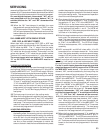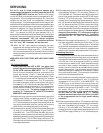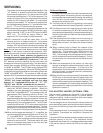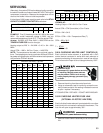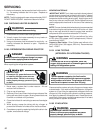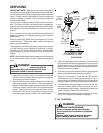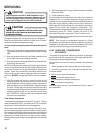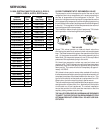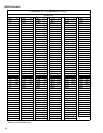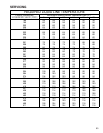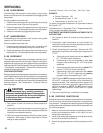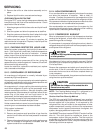
SERVICING
61
IMPORTANT NOTE: Because of the potential damage to
compressors, do not allow suction pressure at service valve
to drop below 20 PSIG when pumping unit system down for
repair. Outdoor section, depending on line set length and
amount of charge in system, may not be able to hold the
entire system charge.
This is the most important part of the entire service proce-
dure. The life and efficiency of the equipment is dependent
upon the thoroughness exercised by the serviceman when
evacuating air (non-condensables) and moisture from the
system.
Air in a system causes high condensing temperature and
pressure, resulting in increased power input and reduced
performance.
Moisture chemically reacts with the refrigerant oil to form
corrosive acids. These acids attack motor windings and
parts, causing breakdown.
The equipment required to thoroughly evacuate the system
is a high vacuum pump, capable of producing a vacuum
equivalent to 25 microns absolute and a thermocouple
vacuum gauge to give a true reading of the vacuum in the
system
NOTE: Never use the system compressor as a vacuum pump
or run when under a high vacuum. Motor damage could
occur.
Do not front seat the service valve(s) with the
compressor open, with the suction line of the
comprssor closed or severely restricted.
WARNING
1. Connect the vacuum pump, vacuum tight manifold set
with high vacuum hoses, thermocouple vacuum gauge
and charging cylinder as shown.
2. Start the vacuum pump and open the shut off valve to the
high vacuum gauge manifold only. After the compound
gauge (low side) has dropped to approximately 29 inches
of vacuum, open the valve to the vacuum thermocouple
gauge. See that the vacuum pump will blank-off to a
maximum of 25 microns. A high vacuum pump can only
produce a good vacuum if its oil is non-contaminated.
LOW SIDE
GAUGE
AND VALVE
HIGH SIDE
GAUGE
AND VALVE
TO
UNIT SERVICE
VALVE PORTS
VACUUM PUMP
VACUUM PUMP
ADAPTER
800 PSI
RATED
HOSES
CHARGING
CYLINDER
AND SCALE
EVACUATION
3. If the vacuum pump is working properly, close the valve
to the vacuum thermocouple gauge and open the high
and low side valves to the high vacuum manifold set.
With the valve on the charging cylinder closed, open the
manifold valve to the cylinder.
4. Evacuate the system to at least 29 inches gauge before
opening valve to thermocouple vacuum gauge.
5. Continue to evacuate to a maximum of 250 microns.
Close valve to vacuum pump and watch rate of rise. If
vacuum does not rise above 1500 microns in three to five
minutes, system can be considered properly evacuated.
6. If thermocouple vacuum gauge continues to rise and
levels off at about 5000 microns, moisture and non-
condensables are still present. If gauge continues to rise
a leak is present. Repair and re-evacuate.
7. Close valve to thermocouple vacuum gauge and vacuum
pump. Shut off pump and prepare to charge.
S-103 CHARGING
WARNING
REFRIGERANT UNDER PRESSURE!
* Do not overcharge system with refrigerant.
* Do not operate unit in a vacuum or at negative
pressure.
Failure to follow proper procedures may cause
property damage, personal injury or death.





